[Preface] [Introduction] [Beginnings] [Antireformation] [Breakdown] [Dreams]
A Genealogy of a Czech millers´family Kysilka
Part Five
When Jirik Kysilko settled down in Kamenne Sedliste, his son Frantisek Kysilka is of age of 10 years. Ten years after, at the end of 1745, he marries Dorota, a daughter of Frantisek Bulva of Chotenov. Exactly one year after their wedding a first child Maria Magdalena (*Nov. 11, 1746) is born, followed by twins Vaclav (Venceslaus) and Anna on August 13, 1749.
After the death of his father Jirik, Frantisek Kysilka became the master of the mill on the 9 February 1753. He was thirty years old already. After 18 months the second twins were born: Frantisek (lived only several months) and Jan (Johan, John). It happened on October 20, 1754. Later they had one more twins (Frantisek and Dorota) and a daughter Lidmila, but apparently none of them reached their adultry.
Two decades passed away and Frantisek´s children became adult. The oldest Maria Magdalena returned to the mill in Porici. Namely, she married Frantisek Karsky, the descendent of that Jan Karsky, whose widow married her grandfather Petr Kysilka in the second half of the 17th century.
The sons Vaclav (Venceslaus) and Jan (Johan) finished their apprentenship and became millers.
An example of Aprentice Attest of the Millers´ Guild of Litomyšl from 1779
The older Vaclav Kysilka married Anna Rovensky of Kamenne Sedliste in autumn 1773 and half a year later he took over the father´s mill No. 41. He paid him 35 three-score in cash and guaranteed to the old master and her wife the dwelling in the mill until their death. Frantisek Kysilka deceased in 1779.
We can imagine, how the mill in Kamenne Sedliste looked like. Its description is given in the Land Register Book:
The mill was located at the western (the upper) part of Kamenne Sedliste, on the right bank of the Desna river, that was here only a small creek, not broader than 1,5 meter. The house was of wood with two or three rooms, the mill´s grinding room and a closet above the ceiling. The mill had one wheel and gear. Three cow sheds and a stable was adjacent to the building. A garden, an orchard and a field belonged to the mill. In the garden´s corner, there was a hazel tree. The cabbage was planted in front of the mill. The location of the mill race is unknown.
The second son Jan Kysilka received his inheritance along with the mother and both sisters. Since he was a miller too, he began to look around for an apropriate mill and a bride in surrounding to become independant.And in his case as chance would have it, there was another mill in the oposite part of Kamenne Sedliste, that vas vacant that time.
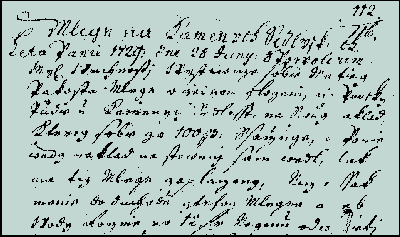
Zápis o postavení mlýna č.p. 2 v Kamenném
Sedlišti v r. 1729
Grundbuch ueber Emphyteutische Mühlen v. 1694
This mill (No. 2 in Kamenne Sedliste) was the only house in the village, built in stone. In 1729 Matej Pakosta, a brother of the miller Vavrinec Pakosta from the upper mill, who later escaped to Prussia, built this mill with the "kind permission of the landlord´s supermacy on the dominical soil" He was given two small pieces of field to the mill and he was obliged to pay to the landlord´s box 12 Kreuzer (krejcar) annually. In 1759 he gave over the mill to his son Daniel, who shortly then died. Matej Pakosta keeps the mill again and in 1767 Daniel´s son, Matej´s grandson Antonin became the new owner. But also Antonin did not live long. In 1775 - 1776 nearly all the Pakosta´s family wiped out, Antonin as the last, in age a bit more than 30 years. Only Antonin´s young wife Katerina (from the Melsa´s kin), their daughter of the same name and the old grandfather Matej Pakosta stayed alive.
So, Jan Kysilka found the housekeeping and his bride simultaneously. He married Katerina Pakosta in summer 1776 before the harvesting, knowing that he would have to keep the mill for Katerina, the living Pakosta´s daughter, when she would become adult and get married.
The witness of the marriage was his brother Vaclav. The wedding trousseau, that Vaclav was obliged to give to his brother besides the share on the father´s mill, consisted of 3 measures of rye, a heifer for meat, one "kopa" Gros for various spices, half barrel of beer and one cow.
Brother and sister-in-law were the godparents of most of Jan and Katerina´s children. On December 10, 1780 Vaclav, the oldest son was born, my grandfather´s great-grandfather. He was followed by Anna, Jan, Daniel, Frantisek, Helena and Marie Magdalena.
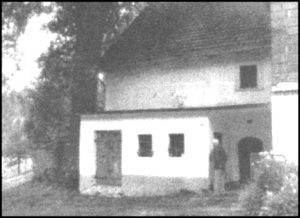
The mill in Kam. Sedlišti No. 2., built in. 1729.
Foto Sept. 10, 1988.
Between 1776 - 1796 the master of the mill was Jan Kysilko and his spouse Katerina.
In 1796 the mill was returned to hands of his step-daughter Katerina of the Pakosta kin.
After her wedding with Josef Stritezsky, their descendents have been living here until
novadays.
The decade 1780 - 1790 was the period of the Entlightenment rule of the emperor Josef II. He abolished the Serfdom, only a lower form of vassalage and compulsory work on landlord´s was preserved. In 1781 the religious freedom was declared. In first four months nearly 4000 people of the Litomysl estate converted to the Protestant belief. There were only two Protestant religions, the Lutherans and the Helvetics, that were allowed, suffered, but not belief of Czech peasants´ ancestors, the Bohemian Unity of Brethren. The Catholic clergy was aware of the rapid increase of non-catholics. Therefore a new provision was addopted, that all, who wanted to convert, must supplie their application form with the particular explanation why they wanted to change their belief and if they knew the basic principles of new religions. During spring 1782 a commission started to investigate, whether the application forms are properly filled in, whether the motivation for conversion is suffiecient and if the applicant had not been forced to the conversion.
In the family of Jan and Katerina Kysilka the brethren faith had been preserved for years. The catholic priest P. Thomas Arazim of Dolni Ujezd complained of the behaviour of the miller Jan Kysilka of Kamenne Sedliste to the Bishopric Consistory just after Epithany 1782: " When the cleric blessed their houses and dwellings and asked for the Epithany money, the miller Kysilko ignominiously said that they would not give any contribution, for a previous year they gave already, for this one, the contribution will be given only to their new Pastor or Administrator."
In February 1782 Jan and Katerina Kysilka made a registration of their conversion to the Protestant faith. The older brother Vaclav remained catholic. Jan and Katerina were interrogated by the religious commission and during this examination they declared:
Q: What is your confession?
A: (we are) both of lamb´s belief.
Q: How long have you confessed this belief?
A: I, the man, for 5 years and I, his wife, from my birth on.
Q: What was the religion of your parents?
A: My parents (the man) were catholics and mine (of the woman) were evangelics -
protestants.
Q: Whe have you laft the catholic faith?
A: I, the man, left the catholic church, since I like the lamb´s belief.
Q: Do you want to return?
A: Neither of us will surrender it (the lamb´s namely).
The father´s Arazim charcteristics of Jan and Kathy Kysilka according to the same source: "Both are people enormously vicious. She, namely the spouse of the same Kysilka, is slanderous in presence of many people, customers in the mill, of saints and saint pictures..."
But after several years Jan Kysilka had even problems with the Protestant Priest Stephan Gaal of Prosec rectory. On Dec. 12, 1791, the priest namely asked the Landlord´s Authority to help to levy the debts of his parish people of Porici and Kamenne Sedliste, among others Kysilka´s debt of 20 Krejcar.
Jan´s stepdaughter went merried in 1792 or 1793 to Josef Stritezsky of Kamenne Sedliste. Their son Jan Stritezsky, later miller in Horni Ujezd No 8(old)/9(new),local judge, chronicler and writer, bee-keeper and organ-builder was born several months later. Katerina, with her man and son and together with the family of Jan Kysilka, lived in the mill and was waiting till she would be twenty-five and according to the contract she inherit the mill after the long-time-ago-died father.
Jan Kysilka therefore tried to find an appropriate mill somewhere, but in vain hopes. He asked the Magistrate of the municipality of Litomysl to allot him a place in the town´s village of Budislav, to build there a house with a saw.
The town of Litomysl sold him 4 measures of land at 105 Guilders in cash. The house with the water saw was built within a year (Budislav No. 114) and the Kysilka was moving to the new site, whereas the mill in Kamenne Sedliste definitelly belonged to the Striteskys.
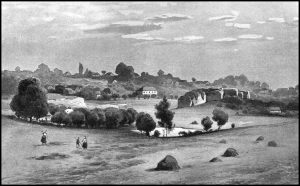
The village of Budislav by K. Liebscher in:Cechy, Eastern Bohemia. 1908.
In 1800, Jan Kysilka, who is now 46 years old, passed over the house in Budislav for 800 Guldens to his son Vaclav Kysilka, a 20-years-old lad.
Four years later, in January 1804 A.D., Vaclav Kysilka married Katerina, a daughter of Matej Vacek of Budislav No. 81. On behalf of the young married couple their parents concluded a written "Wedding Contract". The bride´s dowry was 150 Gouldens in cash and a cow, whereas the groom brought to the matrimony the mentioned house in Budislav.
In A. D. 1808 Vaclav became a member of the Millers´Guild of Litomysl as a "halfmaster of the millers trade" and so he could buy a mill and carry on the millers´trade. He choosed a mill in a small willage of Vranice No. 8 (old No. 13), in a valley of the Vranice creek under the majestic sand-stone rocks of the so called Stables of the Knight of Toulovec (Toulovcovy mastale).
The village of Vranice originated in the 1780s on the cadastral area of three communities - Jarosov of the Municipal estate of Litomysl, Nova Ves and Bor on the estate of Nove Hrady. There were 120 inhabitants in the beginning of the 18th century. Nine houses belonged to the community of Jarosov, eleven to Nova Ves and four to the village of Bor. In respect of the religion administration, the relations vere rather complicated. Vranice was administered by four parishes: three were catholic - in Mladocov, Nove Hrady and Prosec, one parish was a reformed Protestant parish in Prosec. People practised agriculture on poor stony fileds ( oats, rye, flax and potatoes were introduced by the end of 18th century). But to ensure their subsistance, they had to run some trades (shoe-making, wood-pipe carving, weaving) and to work in the wood.
The mill with the saw in Vranice was build already before 1780. The first proprietor was a man named Matej Visek. When he died, his widow married (1781) Frantisek Petru, who cared for the mill until Jan, the "youngest son of Matej Visek grew up".(According to a feudal family law, the heir was the youngest son). But during the Petru´s administration the mill "was desolated at highest and the saw... totally got to wreck". Therefore the supermacy decided that the oldest Visek´s son Josef would take the mill over, and that he would pay off the mill to his brother Jan for 305 Gouldens.
The serf duties, connected with this mill, included 26 days of compulsory work on the landowner´s, twice in a year ( St. George´s and St. Gallus´ Day) the payment of interest of about 1/5 Gulden each time, the payment for providing the water 4 2/3 Gouldens per year and 34 peaces of shingles "in natura".
Josef Visek built up a new saw and a barn. The total worth of the homestead (with the arable fields - 3 1/4 "merice" (abt. 2 acres) and nearly 9 "merice" (4 1/2 acres) of meadows, gardens and pastures) was 2130 Guldens in A. D. 1806. But we must not forget that there was a high devaluation of many during the Napoleonic wars in Austria. In A. D. 1806 Josef Visek had to sell the mill to Josef Zdiara, from whom our Vaclav Kysilka acquired this mill for 5935 Guldens in 1808.
It seems that already in A. D. 1804, there were narrow connections between Vaclav Kysilka and previous owner Josef Visek. He probably worked in the mill as a journeyman. It is based on the fact, that Katerina, the oldest daughter of Vaclav Kysilka and Katerina Vacek was born in the Vranice´s mill on Dec. 25, 1804.
Six years later Vaclav, the first son was born (Jun 10, 1810), being followed again on Christmas 1812 by his brother Jan.
The grandfather Vaclav Kysilka sold his house in Budislav that time and came to his son´s mill to Vranice, where he lived until his death in 1815.
Both syblings - Vaclav and Jan - served their time of apprenticeship as millers as well. How it could be else ! The older Vaclav took over the father´s mill in Vranice at 1200 Gouldens C.W. in 1840. Probably his seven-years-long military service came to an end that time. He served as privat with the Hussar´s regiment in Vienna. He married Katerina Brcal, a daughter of Josef brcal from Olsany in 1842. His wife seems to have died in a short time after, because in 1852 Vaclav married for the second time Frantiska Kostlan of Zderaz. Vaclav and Frantiska belonged to reformed Protestant church in Prosec and they sold the mill in 1854 and moved later to Zabori, which was the next village of Prosec, to be closer to their community. Vaclav was still alive in 1860s. Their only son died short after his birth in 1853. The mill came to hands of some Jan Kokes and later to Jiri Konicek.
We do not know why Vaclav has not sold his mill to his youger brother Jan Kysilka. Jan settled down in the nearby village Jarosov where he married Anna Patava in 1836 and where Vincenc Kysilka, my great-grandfather was born in the same year.
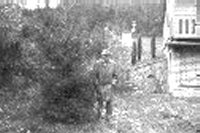 |
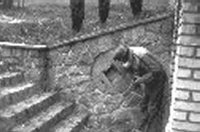 |
The place of a former Vranice mill No. 13/8. todayThe
stone wheel is the only witness
of the former glory .Photo taken in 1983.